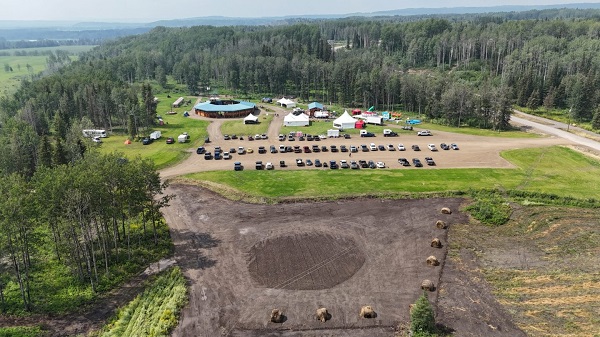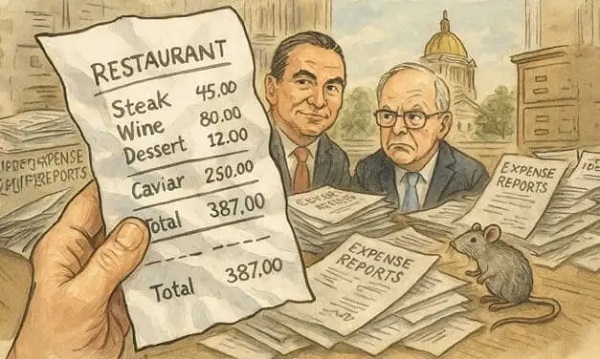Alberta
OPEC+ is playing a dangerous game with oil

This article supplied by Troy Media.
OPEC+ is cranking up oil supply into a weak market. It’s tried this strategy before, and it backfired
OPEC+ is once again charging headfirst into a market share war—a strategy that has repeatedly ended in disaster. Despite weak global demand, falling prices and rising output from non-OPEC countries, the cartel has chosen to flood the market. History shows this tactic rarely ends well for
OPEC+ or oil producers worldwide, including Canada.
OPEC+, a group of major oil-exporting countries led by Saudi Arabia and Russia, works together to manage global oil supply and influence prices. Its decisions have far-reaching consequences for the global energy market—including for Canadian oil producers.
Last Saturday, eight leading members of OPEC+ announced, after a virtual meeting, that they would increase production by 548,000 barrels per day starting in August. That is significantly more than the group’s recent additions of 411,000 bpd, and it puts them on track to fully unwind their
previous 2.2 million bpd in cuts a full year ahead of schedule.
It is a bold move, but it comes at a questionable time.
There is little geopolitical premium built into current oil prices, and the global market is already oversupplied. Brent crude futures are down more than six per cent so far this year. Analysts estimate inventories have been climbing by a million barrels per day in 2025 due in part to cooling demand in China and rising output from countries outside OPEC.
S&P Global Commodity Insights forecasts a supply surplus of 1.25 million barrels per day in the second half of the year. Brent crude stood at about US$68 per barrel on Friday, but S&P says it could fall to between US$50 and $60 later this year and into 2026. West Texas Intermediate, the U.S. benchmark, is also at risk of dropping below US$50 per barrel.
Canada is the world’s fourth-largest oil producer, with most of its output coming from Alberta’s oil sands. Though Canadian producers have higher costs than some OPEC+ members, their innovation and access to U.S. markets have made them increasingly competitive.
While the seasonal demand boost might justify a modest increase, OPEC+, especially Saudi Arabia, appears primarily motivated by market share concerns. With U.S. shale and countries like Canada, Kazakhstan and Guyana gaining ground, the cartel is falling back on its old tactic of flooding the market to squeeze out competitors.
Some observers, including Stanley Reed in The New York Times, have suggested that the move may be designed to please U.S. President Donald Trump, who “has made courting Saudi Arabia and regional allies like the United Arab Emirates a priority of his foreign policy.” But even geopolitical gamesmanship has not shielded OPEC+ from the consequences before—and likely will not this time either.
Back in 2014, fed up with the U.S. shale boom, OPEC opened the taps. The goal was to drive prices low enough to force out higher-cost producers. Instead, oil plunged into the US$30 range. According to the World Bank, the 70 per cent drop during that period was one of the three biggest oil crashes since the Second World War and the most prolonged since the supply-driven collapse of 1986. Saudi Arabia’s respected oil minister, Ali Al-Naimi, lost his job in the aftermath.
Then, in April 2020, as the COVID-19 pandemic loomed, OPEC and Russia launched a production war that sent oil prices into freefall, briefly into negative territory. Trump had to broker a ceasefire to rescue the U.S. shale industry, forcing Riyadh and Moscow to pull back. Both sides suffered significant economic damage.
For Canada, especially Alberta, the current fallout could be severe. The province is home to most of the country’s oil sands production. Cheaper global crude undercuts Canadian prices, squeezes royalty revenues, chills investment and puts jobs at risk across Canada. And this comes as governments are already grappling with fiscal pressures.
The oil market does not reward short-term thinking. If OPEC+ continues down this road, history suggests the outcome will be painful for them and the rest of us.
Toronto-based Rashid Husain Syed is a highly regarded analyst specializing in energy and politics, particularly in the Middle East. In addition to his contributions to local and international newspapers, Rashid frequently lends his expertise as a speaker at global conferences. Organizations such as the Department of Energy in Washington and the International Energy Agency in Paris have sought his insights on global energy matters.
Troy Media empowers Canadian community news outlets by providing independent, insightful analysis and commentary. Our mission is to support local media in helping Canadians stay informed and engaged by delivering reliable content that strengthens community connections and deepens understanding across the country
Alberta
Halfway River First Nation makes history with Montney natural gas development deal

In northeast B.C., about 75 kilometres from Fort St. John, Halfway River First Nation sits in the heart of the Montney, one of North America’s largest natural gas plays. Photo courtesy Halfway River First Nation
From the Canadian Energy Centre
By Will Gibson
Greg Kist has seen plenty of change during more than three decades working in the energy industry. But the former executive with Petronas and Progress Energy has rarely experienced a history-making moment.
That happened in July 2024, when the B.C. government awarded the Halfway River First Nation what’s known as oil and gas tenure in the heart of the Montney play.
It’s an agreement that grants the Nation decision-making authority over the exploration and development of petroleum and natural gas resources on more than 34,000 hectares of Crown land in its traditional territory, located approximately 1,000 kilometres northeast of downtown Vancouver.
That agreement is now moving further into action with a deal between Halfway River-owned Tsaa Dunne Za Energy (TDZE) and ARC Resources.

Members of the Halfway River First Nation participate in a field tour with the BC Energy Regulator in June 2025. Photo courtesy BCER
The agreement, signed earlier this year, will see TDZE work with Calgary-based ARC to develop about 25 per cent of the tenured land.
The region is adjacent to ARC’s existing Attachie natural gas operations, which are rich in high-value natural gas liquids.
The company describes Attachie as one of its most profitable assets, which can be expanded thanks to the TDZE agreement.
“This land was deferred from development for more than two decades while sitting in the premier natural gas play in North America,” says Kist, one of TDZE’s managing executives.
“Unlocking it will generate all kinds of economic activity and royalties for the B.C. government that help pay for schools and health care. But it will also generate the same benefits for the Halfway River First Nation.”
ARC plans to integrate the new areas using existing roads, pipelines and other infrastructure from Attachie.
Developing the land will still require consultation with the Halfway River First Nation.

Drilling in the Montney play straddles the border between northeast B.C. and northwest Alberta. Photo courtesy ARC Resources
“This is very much about Tsaa Dunne Za Energy delivering the best return on this particular asset for its shareholders, which are the members of the Halfway River First Nation,” Kist says.
In addition to granting tenure to develop oil and gas on the land, the B.C. government and Halfway River have implemented a landscape planning pilot to mitigate the impacts of development on the Nation’s Treaty 8 rights and manage potential cumulative effects of new development.
“The tenure award and landscape planning pilot will help to ensure that oil and gas development in these areas is sustainable and managed in accordance with the values of the Halfway River First Nation,” Chief Darlene Hunter said in a statement.
Kist sees the agreement as a template for other governments, energy companies and First Nations to follow.
“This has the potential to be the model for cooperative development so that we can develop resources in the right way that benefits governments, First Nations and industry. I’m proud to be a part of this because everybody involved wins from this.”
Alberta
With no company willing to spearhead a new pipeline under federal restrictions, Alberta takes the lead

Alberta leads as proponent for West Coast pipeline
Alberta’s government, acting as proponent, will lead a technical advisory group of companies with Indigenous participants to advance a West Coast pipeline application.
With the advice and technical support of three major pipeline companies, Alberta’s government, acting as proponent, will develop and submit a formal application for a project of national significance to the Federal Major Projects Office under the Building Canada Act. Indigenous communities in Alberta and British Columbia are being engaged from Day 1. Indigenous co-ownership, partnership and perspectives will be critical to every stage of project development and execution.
The advisory group will undertake the early planning, technical assessment and application for an oil pipeline proposal to the northwest coast of British Columbia. When completed, the project will significantly increase market access to responsibly and ethically produced Canadian crude oil products.
“This project application is about more than a pipeline; it’s about unlocking Canada’s full economic potential. By doing this the right way from Day 1 with Indigenous partners and industry expertise, we will deliver a proposal that proves this project is undeniably in the national interest. Together, we are charting a path to secure Canada’s energy future for generations while bringing the world’s most ethically and responsibly produced energy to market.”
The goal of this planning and pre-front end engineering and design work is to determine the general path and size of the pipeline, quantify costs, initiate early Indigenous engagement and partnership, and make the clear case that this pipeline is in the national interest. Alberta’s government will contribute $14 million to support early planning work including cost estimates, engagement and development of a credible proposal for federal consideration.
“We already see Canada as an energy powerhouse, and with the right infrastructure, moving toward superpower status is both realistic and achievable. Increased market access from Alberta to tidewater will scale Canada’s export markets and diversification, while supporting the federal government’s newly stated ambition of becoming an energy superpower.”
Indigenous leadership and perspectives are essential to guiding major projects like this that will grow our economy, safeguard the environment and create lasting opportunities for Indigenous partners. Our engagement strategy will reflect the diversity of Indigenous governance structures and be tailored to reflect each community’s unique context. By bringing together innovation and technology with Indigenous perspectives and cultures, we are creating the conditions for meaningful dialogue and the right mix of expertise to shape a project that reflects shared values and priorities.
“This is about partnerships and building trust from Day 1 – ensuring Indigenous voices shape the decisions that affect their lands and futures. Alberta’s government is committed to respectful, transparent engagement that recognizes Indigenous communities as rights holders, leaders and owners in the prosperity we build together.”
“Fort McKay First Nation welcomes the opportunity to be engaged from the very beginning of this important project. True partnership means listening to Indigenous voices, respecting our lands and ensuring our people share in the benefits. By working together with government and industry, we can create opportunities that strengthen our communities, while showcasing the incredible potential of Alberta’s energy sector.”
“The National Coalition of Chiefs has always said that oil and gas participation, including ownership opportunities, can be a way to drive economic reconciliation. We are happy that Alberta is leading an effort to get another pipeline to the West Coast, and we are especially happy that they have decided to engage with Indigenous nations in B.C. and Alberta right from the very beginning of the process.”
The technical advisory group will include multiple industry participants, bringing expertise in engineering, construction, Indigenous relations and market demand. The groups efforts will be supervised by a panel that currently includes:
- Larry Kaumeyer, deputy minister, Energy and Minerals (co-chair)
- Alex Pourbaix, executive chair, Cenovus (co-chair)
- Rajan Sawhney, Minister of Indigenous Relations
- Hal Kvisle, energy industry executive
- Roderick Graham, board director, AER
- Chief Jim Boucher, chair, president and co-founder, Saa Dene Group of Companies
- Al Monaco, former president and chief executive officer at Enbridge
- Corey Bieber, board director, Vermilion Energy
- Chris Sankey, principal owner and president, Blackfish Enterprises
- Dave Lamouche, president, Metis Settlements General Council
The project of national significance application process will explore all opportunities to deliver Alberta’s responsibly produced energy resources to market, while carefully assessing all aspects required to advance a northwest coastal crude oil pipeline.
Quick facts
- The expected application submission to the Federal Major Projects Office is approximately spring of 2026.
- The three companies participating in the technical advisory group are South Bow, Enbridge and Trans Mountain.
- Canada has the fourth-largest proven oil reserves globally and is the fourth-largest global oil producer.
- Net export receipts of crude oil have climbed from $6 billion in 2000 to $130 billion in 2024.
- Additional infrastructure from Alberta’s oilsands to B.C.’s coast will ensure Alberta energy resources can contribute to meeting significant Asian demand from countries like Japan, Korea, China and India.
-

 Censorship Industrial Complex2 days ago
Censorship Industrial Complex2 days agoCanada To Revive Online Censorship Targeting “Harmful” Content, “Hate” Speech, and Deepfakes
-

 Alberta2 days ago
Alberta2 days agoAlberta refuses to take part in Canadian government’s gun buyback program
-

 Business1 day ago
Business1 day agoTaxpayers deserve proof of how politicians spend their money
-

 Business1 day ago
Business1 day agoOttawa’s civil service needs a Chrétien-style reset
-

 Alberta2 days ago
Alberta2 days agoOrthodox church burns to the ground in another suspected arson in Alberta
-

 Fraser Institute1 day ago
Fraser Institute1 day agoAboriginal rights now more constitutionally powerful than any Charter right
-

 Alberta1 day ago
Alberta1 day ago$150 a week from the Province to help families with students 12 and under if teachers go on strike next week
-

 International1 day ago
International1 day agoTrump gives Hamas four days to choose: peace or obliteration






